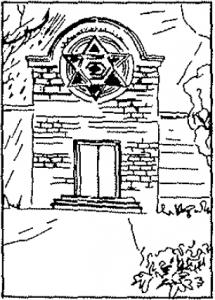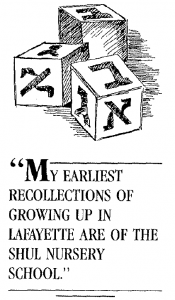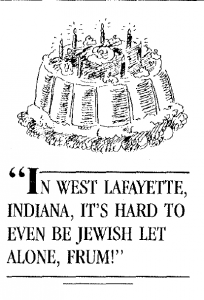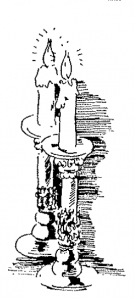Growing Up Jewish in Indiana
By Edward Simon, Ph.D.
 Although my four children were all raised in West Lafayette, Indiana, the home of Purdue University where I am a Professor of Biology, I have been blessed with two Rabbis and a rebbitzen plus a second daughter who is well on her way to joining her siblings. People have often asked me how my wife and I accomplished this. I had my ideas, but decided that it would be interesting to ask my children for their own thoughts on the matter. A year ago I did so, and after some urging I finally got all four accounts. I think that they make interesting reading; mostly because the ideas are so diverse. They range from Shira’s almost mystical account to Rashi’s strictly pragmatic one. Ronit had a little more of a choice by the time she grew up, but can hardly wait to go to a “real yeshiva.”
Although my four children were all raised in West Lafayette, Indiana, the home of Purdue University where I am a Professor of Biology, I have been blessed with two Rabbis and a rebbitzen plus a second daughter who is well on her way to joining her siblings. People have often asked me how my wife and I accomplished this. I had my ideas, but decided that it would be interesting to ask my children for their own thoughts on the matter. A year ago I did so, and after some urging I finally got all four accounts. I think that they make interesting reading; mostly because the ideas are so diverse. They range from Shira’s almost mystical account to Rashi’s strictly pragmatic one. Ronit had a little more of a choice by the time she grew up, but can hardly wait to go to a “real yeshiva.”
Somewhat to my surprise there is little consensus among the children regarding the reasons for their development along Jewish paths. At every opportunity we all made what my wife calls the “Jewish choice,” even the heartrending one of sending the children out of town to yeshivot or day schools when they reached the age of 11-13 years. But that was not enough, from birth onward the children were prepared for the course their lives would take (their overtly Jewish names were no coincidence). When the boys were born, their briths were the biggest social occasions of the type the city had ever seen. And remain so to this day. This was despite the fact that we ourselves were relative newcomers at that time. When Shira was three we had the first private succah in the city (now there are several). A year or so later we were instrumental in forming a Shul nursery school which is in existence to this very day.
My wife formed two study groups (shul and Hadassah) which have met continuously for more than 25 years. I formed a Talmud class which continues after 20 years. We were the backbone of a chumash class which is now in recess after 20 years of weekly meetings. (All of these classes have the rather unique attribute of requiring preparation by all of the participants). In addition my wife and I have been officers continuously in just about every Jewish organization in the city. The significance of this is that the children were well aware—at times painfully aware—of our deep involvement in the Jewish community. They knew that for us Yiddishkeit was neither for our parents or our children, but for each and every member of the family and at every level of our being. From the scut work of a garage sale, to making sure that the children were tops in their Hebrew classes (surprisingly they almost never were) to preparing a shiur for the Talmud class and walking the four mile round trip to shul in summer and winter.
Two episodes stand out which indicate how deeply the children had become imbued with Jewish values even at an early age. On the way up to the Catskills on the fateful trip that Shira describes in her essay, we stopped at a “Yiddish” hotel to visit a relative. Shira was immediately surrounded by some of the older guests, who commented that she looked as “pretty as a shiksa” whereupon she immediately burst into tears. Shocked, they wanted to know what had happened? “No one calls my daughter a shiksa,” I replied. It was the event of the week. Some years later, I was learning Talmud with Shira and Rashi in my bedroom, having sent Hillel (who was about 5) away. A few minutes later I heard a noise at the door, and there was Hillel lying down on the floor with his car pressed to the crack trying to hear what I was teaching. He joined the group from that day forth. The similarity to the famous story of Hillel Hazaken was uncanny.
I really do not know what my wife and I have done right; perhaps someone who is more astute can find out from a close reading of the children’s essays. But my purpose in writing this is merely to demonstrate that with God’s help it can be done! I feel very strongly that Jews (and frum Jews!) must live everywhere. In Israel, of course, but also France, England, Argentina and the United States. And within America, in New York certainly. But also in Chicago, Los Angeles, Ohio, Missouri, and even West Lafayette, Indiana. First, it is our duty to be a “light unto the nations” and second, unfortunately our very dispersal has time and again been our salvation. True, there are the great dangers of assimilation, but that happens in big cities too. As a minimum, any child that was brought up in our congregation is well aware that he is Jewish. Few become Rabbis or even frum, but no one can claim that he was unaware of what he was and what was expected of him. How many in New York can say that?
Growing up Jewish in Indiana, and similar locations is not easy. Not on the children, and certainly not on the parents. But with the pain and the difficulty come special rewards. Someday, I hope even my children will agree.
*****
It’s been six long years. Everything is so different . . . yet the same. Six years ago, I saw the same home, the same neighborhood, the same people . . . but it’s changed. Not that the city underwent drastic construction, nor have its inhabitants gone through a “renaissance.” No. Aside from a few decorative accents my childhood home is the same. It is I who have changed. Where are the hundreds of children running around, to which I had become accustomed in B’nai Brak? Where are the Shaines stores and the shuls? The Tznius? The sense of belonging?
SHIRA
Age
27
West Lafayette, Indiana was once my home, but it is no longer where I belong. I arrived at the Purdue University town at the tender age of one year. My father, a biologist, had accepted his first job offer and Baruch Hashem has been happy with his position ever since. My mother from a cultural Jewish background, never expected to actually settle in a town with so little Jewish content. However, being a leader by nature, she had little difficulty getting involved in (and creating) various Jewish events in the community.
I was raised among non-Jews very different from myself, and had few friends. However, it generally didn’t bother me. I always felt proud to he a Jew, an attitude planted in me by my father. My mother’s constant encouragement and practical advice helped me through hard times, such as having Kosher food at girl scout camp, not joining classmates on Saturday get-togethers, and the numerous school absences due to Yomim Tovim. Positive reinforcement in all aspects, along with strictness from both parents, went a very long way. Of course, having two younger brothers in a similar situation as myself, helped me feel less lonely.
The Hebrew school required only one hour of class time a week, plus several hours of homework. However, my mother would not settle for anything less than perfect attendance and preparation. And this brought its importance home to me. “Hashachar,” the community youth group, served as a social outlet for the children. Needless to say, only a few were religious.
However, my neshama, nurtured by my parents, sought higher goals than continuing through public high school and college, as was the norm in our society. I yearned for ruchniot in my own, naive way. When I was nine, the opportunity arose to be with religious Jews in a small Catskill resort. I grasped every aspect of Yiddishkeit that I could. Other events which influenced me greatly, were the summer visits to our home by the Lubavitcher Hassidim, as part of their “Jewish Peace Corp” program. Although I am now married to a “Chazon Ishnic” (misnagid), I must admit that much of my religious development came from them. It followed naturally that I would want to continue this spiritual growth, despite the difficult environmental circumstances.
I spent my 8th grade year in Israel, where my father was on sabbatical leave at the Hebrew University Medical School. While there I attended a state supported religious school. Although I had a great time on the B’nai Akiva walking trips, I didn’t learn true authentic Judaism. However, at the end of our stay, a teacher convinced me to do what I had known all along that I needed. A few days after our arrival in the United States (with a baby sister born just before the Yom Kippur war), I was enrolled in Bruria High School in Elizabeth, New Jersey. While attending the school, I was to live with my maternal grandmother. My parents let me make the decision, but were very supportive. In addition to the frum teachers, the NCSY youth group was very helpful to me in all aspects of my spiritual growth. “Going away” for shabbos was my favorite pastime.
Suddenly, West Lafayette was transformed to a vacation resort for me, where the struggle to practice all my new “chumros” (as my father called them), continued. My brothers, in turn, went to yeshivot; probably because my parents were satisfied with my education. After four successful years in Bruria, seminary in Israel was the natural continuation of my studies. Wherever I went, I was very proud to say I was from West Lafayette, Indiana. Although, depending on whom I talked to, it was “Purdue University,” “Indiana,” or simply “not New York.”
As the years went by, my parents motivated by their periodic trips to Israel, realized the kedusha of my new lifestyle, and they too continued to grow more and more in Torah ways, painfully sending each child in due course away from home to give them the opportunities they deserved.
It was wonderful visiting Indiana from B’nai B’rak with my husband and baby. But now I feel sorry for the people who are missing so much in their lives. I’m surprised that people manage altogether. Their children, if they marry at all, intermarry.
My parents work day and night at kiruv in their own way. But they have little help and there is such a long way to go. A long way. . . .
*****
Today I live in Yerushalayim, one avreich (married yeshiva student) among thousands in the city, easily a hundred in my neighborhood alone. I relish the Torah-suffused atmosphere of my surroundings, where I—baruch Hashem—feel very much at home. But Yerushalayim was not always home to me. Permit me to share with you some reflections on growing up in Indiana.
RASHI
Age
26
Unlike a great number of American avreichim in Israel, I did not become a baal teshuvah as an adult, taking on a new name and identity after tasting freely of the “outside world.” Nor, like the other large group, was I born into a frum family in metropolitan New York, making my way through the yeshiva system to a kollel in Eretz Yisrael in the venerable spirit of heveh goleh le-makom Torah (seek out a place to study Torah). Rather, I was born and raised in West Lafayette, Indiana. Yet, already as a child I wore a kippah and, later, tzitzit, though I went to public school through ninth grade. Nor has my name changed over the years: My parents named me Rashi, and that’s what I’ve been ever since.
For those who may be unfamiliar with my hometown (Indiana can be located on any map of the United States—look near Lake Michigan), allow me to describe it for you. West Lafayette, located in the northern third of the state and nestled among countless acres of cornfields, is the home of Purdue University (no relation to the purveyor of poultry with a similar name). The population, as the locals have it, is “20,000 people—plus 30,000 students.” Actually, the relationship between the two groups is rather congenial, considering that almost all the townspeople earn their livelihoods, either directly or indirectly, from the university. My father, a professor of biology, is among these.
The Jewish population (including Lafayette—population 50,000—the older community on the other side of the Wabash River) by all accounts does not exceed 800 souls. The Jewish community is served by two congregations. One is a Reform temple, the other a “traditional” shul (an appellation interpreted by one member as meaning that “we’re Conservative but we don’t want to admit it”). Besides the shul rabbi (at times) and the Hillel director (at the University), for the past 20 years mine has been the only Sabbath observant family in the city.
The credit for my having emerged with any kind of Jewish commitment from the spiritual wilderness of West Lafayette goes to my parents, much more than to me. My main personal asset (and this too may be as much nurture as nature) is a willingness to be different, to stand out from the crowd. I cannot claim, for example, that at the age of eight, when I first began wearing my kippah to school, I was motivated only out of religious zeal. It was also my way of non-conformance. But it was Jewish way, and I was proud—and keenly aware—of that important fact.
 This brings me to what I believe is the “secret” to raising Jewishly, and even halachically committed children in laid-back, WASP-dominated mid-America, and for that matter, in the open society in which all (or almost all) American Jews live. From my earliest childhood, my parents always taught us that Jews are different from everyone else; and that, although being Jewish most assuredly brings with it a host of formidable, sometimes onerous obligations, it is my greatest fortune and joy to have been born Jewish. (Incidentally, the insistence that, come what may, it is good to be a Jew was a favorite admonition of R. Moshe Feinstein, zt’l) This assertion, besides permeating our family life, was a leitmotif in the bedtime and Shabbos morning to-and-from shul (four miles round trip) stories which my father told us. When I was somewhat older (perhaps 7 or 8), I remember that this axiom was given further weight by the observation, borne out by events in Europe in my parents’ own lifetimes (though they are both American born) that even if a Jew tries to forget that he, is different, he can expect to be reminded, rudely by his gentile neighbors.
This brings me to what I believe is the “secret” to raising Jewishly, and even halachically committed children in laid-back, WASP-dominated mid-America, and for that matter, in the open society in which all (or almost all) American Jews live. From my earliest childhood, my parents always taught us that Jews are different from everyone else; and that, although being Jewish most assuredly brings with it a host of formidable, sometimes onerous obligations, it is my greatest fortune and joy to have been born Jewish. (Incidentally, the insistence that, come what may, it is good to be a Jew was a favorite admonition of R. Moshe Feinstein, zt’l) This assertion, besides permeating our family life, was a leitmotif in the bedtime and Shabbos morning to-and-from shul (four miles round trip) stories which my father told us. When I was somewhat older (perhaps 7 or 8), I remember that this axiom was given further weight by the observation, borne out by events in Europe in my parents’ own lifetimes (though they are both American born) that even if a Jew tries to forget that he, is different, he can expect to be reminded, rudely by his gentile neighbors.
Parenthetically, I must stress that my own home, in common with all the homes with which I was familiar as a child, fostered notable unprejudicial views with regard to race, nationality and the like. (In fact, when I later went away to yeshiva, I found the contrasting viewpoint which prevailed there in this matter to be quite unsettling.) It is not for me to judge anyone else’s worthiness. But one thing I knew: Jews are different. An excellent popular treatment of this important concept by Professor (now Rabbi) David Gottleib may be found in “Dialogues #2: The Chosen People,” The Jewish Observer 19:9 (Dec. 1986).
In school, the most troubling experience for me, religiously, was the singing of “seasonal” songs in music class (generally limited to December and April). While the symbols associated with the two prominent Christian holidays never held much appeal to me (being no match whatever, in my mind, to a Chanukah menorah or a Pesach seder), the songs would relentlessly ring in my ears, a fact which, as a young child, would greatly upset me. (This was before the era of Uncle Moishy, 613 Torah Avenue, and the like. Perhaps they would have served as an effective antidote.) By the time I was in fourth or fifth grade my mother would ask that I be excused from attending those particular sessions, a request which was always granted.
So what was wrong about growing up in Indiana? Looking back, my greatest flaw Jewishly at the time, let’s say, of my bar mitzvah, was not so much deficiencies of knowledge or observance—though both very certainly below what they might have been had I been living in a Jewish community of size—but the feeling of self-centeredness and complacency with respect to my level of Torah and mitzvot. Imagine: Being at the time the uncontested “frummest” bar mitzvah boy in town—with no one else even in the running—made it difficult for me to appreciate how little of Judaism I really knew and how far I really was from true fidelity to the Halacha. Like Gulliver in Lilliput, I appeared to all (and not least to myself) as a Jewish maximalist, while in fact having a narrow, minimalist view of what Orthodox Judaism is all about.
 While in the East I became involved in NCSY, an involvement which continued upon my return to Indiana. The role models and camaraderie of NCSY helped to bring about a religious maturation and truer self-perception, which in turn led to my decision, without parental coercion, to attend a (different) yeshiva for tenth grade, where I stayed for the remainder of my high school years.
While in the East I became involved in NCSY, an involvement which continued upon my return to Indiana. The role models and camaraderie of NCSY helped to bring about a religious maturation and truer self-perception, which in turn led to my decision, without parental coercion, to attend a (different) yeshiva for tenth grade, where I stayed for the remainder of my high school years.
Perhaps, I am too much a Hirschian, or, to paraphrase a comment of R. Mordechai Katz to R. Elya Meir Bloch (late Roshei Yeshiva of Telshe, who transplanted the Lithuanian citadel of Torah to Cleveland, Ohio), perhaps I am unaware of how much West Lafayette is still in me, but, in retrospect, I don’t believe my growth as ben Torah (devotee of Torah) or y’rei shamayim (fearer of Heaven) was impaired by the years I spent at hom in West Lafayette. To borrow a construct from Maharal Prague, the greatest yearning comes from the greatest deprivation. When I ultimately did go away to yeshiva, I pursued my studies with an earnestness, drive, and sincerity which has baruch Hashem sustained me until today.
*****
My earliest recollections of growing up in Lafayette are of the Shul nursery school. There was, of course, much Jewish content, and although I remember little specifically, I was always eager to go in the morning.
Once I entered public school, I spent a great part of the day among goyim and in a goyish atmosphere. Almost the only Jew in the school, I began wearing a Kippah in first grade.
RABBI HILLEL SIMON
Age
22
 This kept me distanced from my classmates, but I don’t believe I was harassed as a Jew. My natural aloofness and disinterest in sports (in contrast to my brother), also limited my extracurricular contact with the goyim around me. There were times I would voluntarily read a dictionary during recess, rather than play ball. The major difficulty was with goyish holidays, and the accompanying slate of activities and songs, not to mention non-kosher condiments, etc. I was uncomfortable doing or not doing these activities, but it certainly had no lasting effect. I did, however, go “trick-or-treating” for several years until we comprehended the pagan source and overtones of Halloween. My greatest support, to be sure, was the strong motivation for Jewish identity and practice at home.
This kept me distanced from my classmates, but I don’t believe I was harassed as a Jew. My natural aloofness and disinterest in sports (in contrast to my brother), also limited my extracurricular contact with the goyim around me. There were times I would voluntarily read a dictionary during recess, rather than play ball. The major difficulty was with goyish holidays, and the accompanying slate of activities and songs, not to mention non-kosher condiments, etc. I was uncomfortable doing or not doing these activities, but it certainly had no lasting effect. I did, however, go “trick-or-treating” for several years until we comprehended the pagan source and overtones of Halloween. My greatest support, to be sure, was the strong motivation for Jewish identity and practice at home.
My Jewish education had two aspects. There was a lot of learning with my brother and sister at home, at dinner, at bed times, and especially on Shabbos. My mother instilled a love of all things Jewish, songs in particular. She exemplified the Jewish attribute of self-giving in hosting guests and organizing community events, etc.
On Shabbos, there was a release from secular surroundings and more time was spent on religious activities. Friday night, we davened at home, each child reading aloud a section of Kabalat Shabbat, with much singing interspersed. For several years, after the shabbos meal, one child delivered a prepared discussion of one or two Mitzvot in the Rambam’s Sefer Hamitzvot. In the morning, we had a four mile walk to and from shul. Although we had to endure the heat and cold it was good training in self-sacrifice for Yiddishkeit, and also provided a golden opportunity for learning and stories from my father.
 The shalosh regalim were all big events in my home. Pesach featured a spiritually and physically lavish seder with twenty to twenty-five guests each night. We, of course, had much cleaning to do, but we also prepared commentaries and rehearsed the songs which adorn the Hagadah service (many being unique to our family). On Shavuos, we had a learn-in with 10 to 20 participants learning into the night. (Each participant was asked to prepare a 10 minute talk on a subject of Jewish interest.) On Succos, we erected a large succah, with much work in cutting schach from our trees and bushes. Over the moed, we hosted most of the shul community.
The shalosh regalim were all big events in my home. Pesach featured a spiritually and physically lavish seder with twenty to twenty-five guests each night. We, of course, had much cleaning to do, but we also prepared commentaries and rehearsed the songs which adorn the Hagadah service (many being unique to our family). On Shavuos, we had a learn-in with 10 to 20 participants learning into the night. (Each participant was asked to prepare a 10 minute talk on a subject of Jewish interest.) On Succos, we erected a large succah, with much work in cutting schach from our trees and bushes. Over the moed, we hosted most of the shul community.
When I was approximately ten years old, my brother and sister left for yeshiva. Their periodic visits home raised the level of shmiras hamitzvot in our home. I particularly remember my brother prodding me to wear tzitzit.
For many years, representatives of the Lubavitcher Rebbe, Shlita, as part of the countrywide project, have come to Lafayette in the summertime to fan the spark of Yiddishkeit in the hearts of the Jews of the town. In my case, they convinced my father to send me to Gan Yisrael, the Lubavitch camp in the Midwest. I highly enjoyed my experience there, and it awoke in me a great desire to enter a Torah observant school and surroundings.
I have since been in several yeshivot; and presently learn in Crown Heights, under the Lubavitchcr Rebbe, Shlita. I visit home on Yom Tov and in the summertime. While there, I try to bring my knowledge and inspiration to the town b’ezras Hashem.
*****
In West Lafayette, Indiana it’s hard to even be Jewish let alone frum! Especially with all the goyim around; but, with a lot of support from my parents, sister and brothers, I survived. It wasn’t easy though, I had to really work hard. Like being made fun of because of my religion, or children looking at me like I was some kind of freak because I couldn’t eat meat and milk together.
RONIT
Age
13
Some other hard things were not being able to go to parties, or not seeing movies with some friends because they decided they wanted to go on Shabbos. I remember in the second grade I almost ate a non-kosher cupcake thinking it was kosher. Luckily, the teacher remembered that I could only eat special foods. So she asked me if I was sure I could eat these cupcakes. I said I wasn’t sure but to be safe I better not eat it. Boy was that close!
 Another time I was about eight and walking the two miles home from Shul with my father on Yom Tov and a state trooper stopped us and asked me why I wasn’t in school. So my father explained that it was Yom Tov and that’s why I couldn’t go to school. Then the trooper asked if I wanted a ride home; without my father having to say anything, I immediately said no thanks, because you’re not allowed to ride either.
Another time I was about eight and walking the two miles home from Shul with my father on Yom Tov and a state trooper stopped us and asked me why I wasn’t in school. So my father explained that it was Yom Tov and that’s why I couldn’t go to school. Then the trooper asked if I wanted a ride home; without my father having to say anything, I immediately said no thanks, because you’re not allowed to ride either.
A few goyim understand about keeping kosher and things like that. One time somebody in the fourth grade had a birthday party and was going to bring something to school for us to eat, but before he decided what to bring, his mother called my mother and asked what I could have. One of my best years was in the fifth grade. That was the year I taught everybody some Hebrew and Chamaish Avanim (5 Stones), a very popular game I learned in Israel.
Sixth grade was the worst and hardest year. That was because my old school closed and the new teachers and students didn’t understand about my being “frum.” So all the students were making fun of me for this reason and that. For example, l did not wear pants or shorts; they just couldn’t understand why, and it was very hard to explain it to them.
I was happy when sixth grade was over. I was even happier when my parents decided it was time for me to go to another school. A Jewish one this time. I’m so glad that my parents decided to send me to the Hebrew Academy of Indianapolis. However, I can’t wait until I finish eighth grade. Then I can go to a really frum school. A real Yeshiva! So this is where I am, a “frum” girl going into the eighth grade and looking forward to being in a nice “frum” area when I get only a little older.


